#sancho ii of castile
Explore tagged Tumblr posts
Text
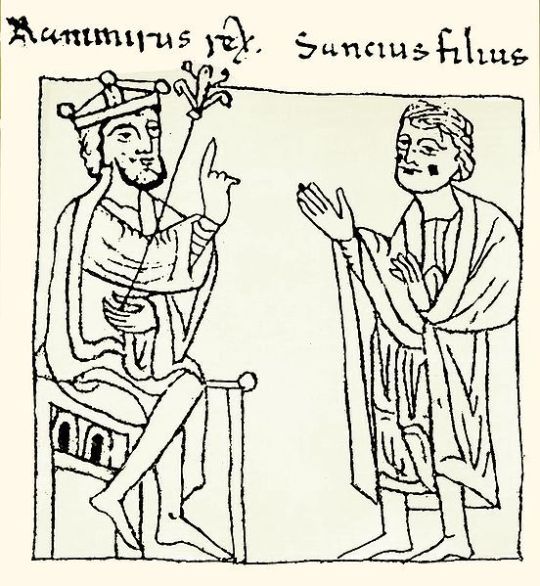

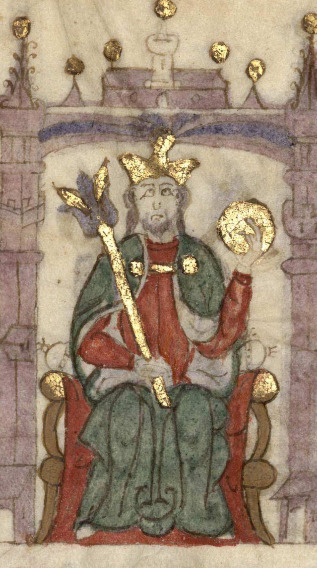
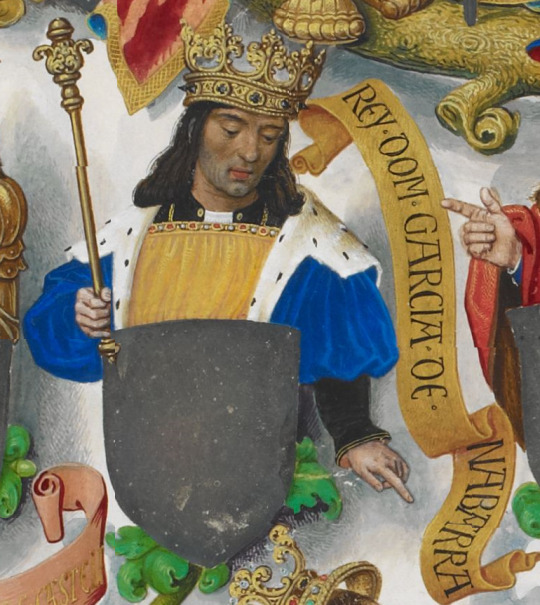


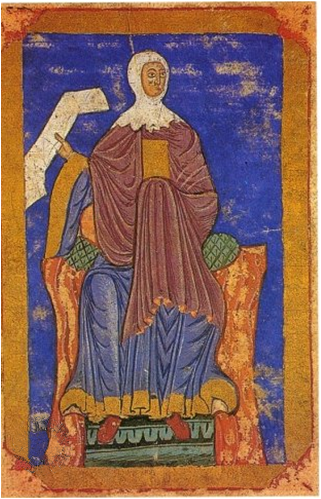

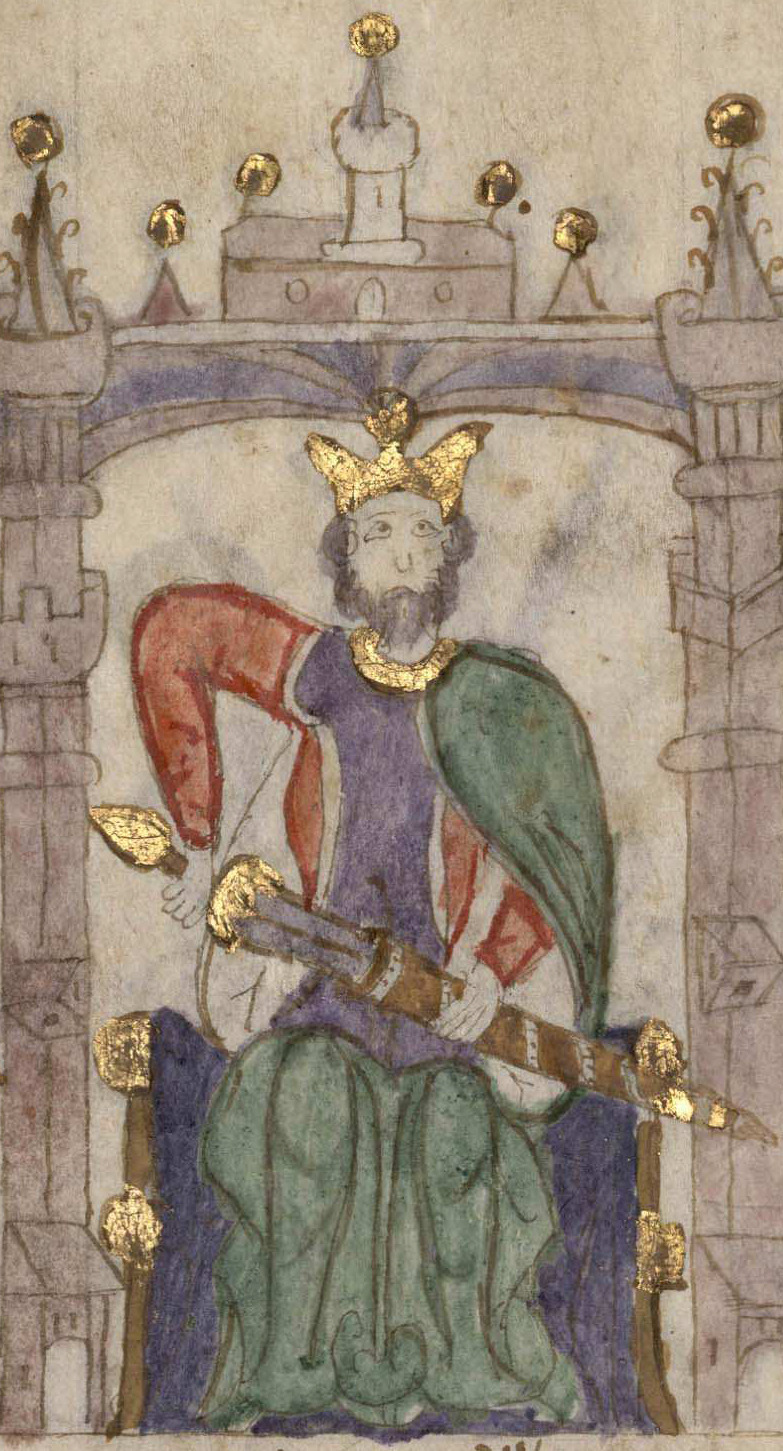
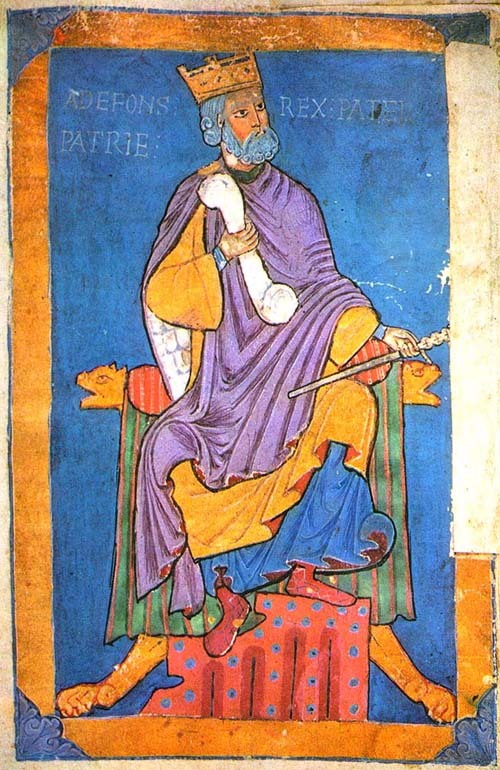
The Bastard Kings and their families
This is series of posts are complementary to this historical parallels post from the JON SNOW FORTNIGHT EVENT, and it's purpouse to discover the lives of medieval bastard kings, and the following posts are meant to collect portraits of those kings and their close relatives.
In many cases it's difficult to find contemporary art of their period, so some of the portrayals are subsequent.
1) Ramiro I of Aragon (1006/7- 1063), son of Sancho III of Pamplona and Sancha de Aybar; with his son Sancho I of Aragon & V of Pamplona (1043-1094)
2) His wife, Ermesinda of Foix (1015 - 1049), mother of Sancho I of Aragon. Daughter of Bernard Roger de Foix and his wife Garsenda de Bigorra; and Sancha of Aragon (1045-1097), daughter of Ramiro I and Ermesinda
3) His father, Sancho III of Pamplona (992/96-1035), son of García II of Pamplona and Jimena Fernández
4) His brother, García III of Pamplona (1012-1054), son of Sancho III of Pamplona and his wife Muniadona of Castile
5) His nephew, Sancho IV of Pamplona (1039- 1076), son of García III of Pamplona and his wife Placencia of Normandy
6) His brother, Ferdinand I of Leon (1016- 1065), son of Sancho III of Pamplona and his wife Muniadona of Castile
7) His niece, Urraca of Zamora (1033-1101), daughter of Ferdinand I of Leon and Sancha of Leon
8) His niece, Elvira of Toro (1038-1099), daughter of Ferdinand I of Leon and Sancha of Leon
9) Sancho II of Castile (1038/1039-1072), son of Ferdinand I of Leon and Sancha of Leon
10) Alfonso VI of Leon (1040/1041-1109), son of Ferdinand I of Leon and Sancha of Leon
#jonsnowfortnightevent#jonsnowfortnightevent2023#asoiaf#a song of ice and fire#day 10#echoes of the past#historical parallels#medieval bastard kings#ramiro i of aragon#sancho i of aragon#sancha of aragon#ermesinda of foix#sancho iii of pamplona#garcía iii of pamplona#sancho iv of pamplona#ferdinand i of leon#urraca of zamora#elvira of toro#sancho ii of castile#alfonso vi of leon#bastard kings and their families#canonjonsnow
30 notes
·
View notes
Photo
@asongofstarkandtargaryen


“We’re talking about killing your father.” “We’re talking about justice!”
“But justice is more important than blood!”
Siempre supe que lo tuviste todo para poder reinar.
El Cid (2020–), 1x04 | 2x03
#El Cid#Sancho II de Castilla#Urraca de Zamora#Urraca of Zamora#Sancho II of Castile#Alicia Sanz#Francisco Ortiz#El Cid 1x04#El Cid 2x03
30 notes
·
View notes
Text
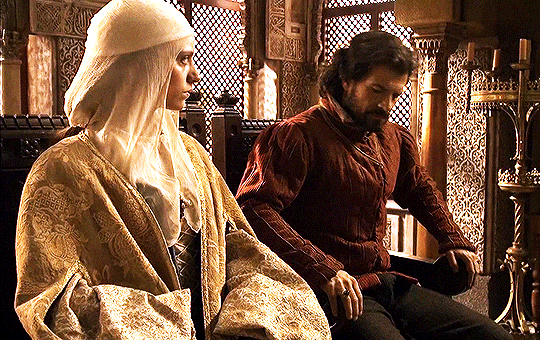




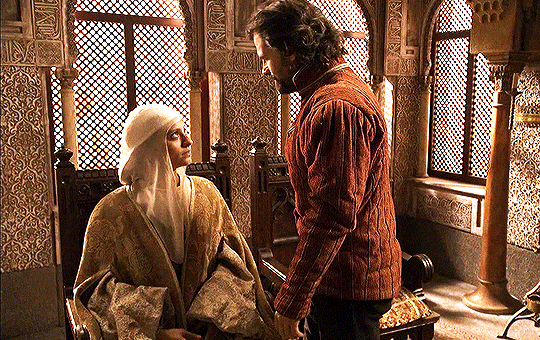
ISABEL TVE 2x06
#perioddramaedit#perioddramasource#weloveperioddrama#isabel tve#2x06#isabella i of castile#ferdinand ii of aragon#michelle jenner#rodolfo sancho
97 notes
·
View notes
Text

Petronila I of Aragon
(1136-1173)
She was the first fully-fledged woman queen of Aragon, with a title in her own right. Petronila came to the throne through special circumstances. Her father, Ramiro, was bishop of Barbastro-Roda when his brother, Alfonso I of Aragon, died without an heir in 1134, and left the crown to the three religious military orders. His decision was not respected: the aristocracy of Navarre elected a king of their own, restoring their independence, and the nobility of Aragon raised Ramiro to the throne. As king, he received a papal dispensation to abdicate from his monastic vows in order to secure the succession to the throne.

King Ramiro II the Monk married the daughter of the Count of Poitiers, Agnes of Aquitaine, a widow of proven fertility who had given birth to four children in her previous marriage. The expected heir to the throne was born in 1136. For first time, the destiny of Aragon fell on a girl, named Petronila. Almost since her birth, she was a key piece in the political games of the Iberian Peninsula. When Petronila was just a little over one year old, was betrothed to Ramon Berenguer IV, Count of Barcelona, who was twenty-three years her senior.
King Ramiro abdicated and returned to monastic life. Queen Agnes crossed the Pyrenees again and confined herself to the Abbey of Fontevrault, where she died years later. There is no evidence that Agnes took any part in the affairs of her daughter Petronila. Except for the first few weeks of her life (without the possibility of any recollection) and entrusted to the care of a housekeeper, Petronila never saw her mother.

Her future husband refused to take charge of her education, and the girl was sent to Castile to be educated by her sister-in-law Berenguela of Barcelona, queen of Castile. In Castilian lands, King Alfonso VII wanted to marry Petronila to his son, the infante Sancho, heir of Castile. The Aragonese nobility, alarmed by this situation, met in Cortes to demand the return of the young queen to Zaragoza. Also her father, Ramiro II, threatened to abandon his monastic retreat to defend the interests of the kingdom, and his daughter. Finally, Petronila left Castile and returned to Aragonese lands.

When Petronila was fourteen, the betrothal to Ramon Berenguer IV was ratified at a wedding ceremony held in the city of Lleida. This marriage sealed the union of Aragon with the Catalan counties, so Queen Petronila has gone down in history as the mother of the Crown of Aragon.
The relationship between Ramon and Petronila was stable and fruitful, although he, with more experience and authority, played a predominant role in government affairs, she was not a submissive queen. Petronila was aware of her power as the legitimate heir to the Aragonese throne and remained firm in her role, although discreetly.

Petronila and Ramon developed a relationship of mutual respect, where trust and political collaboration prevailed over any differences. Ramon Berenguer was never king. The Count of Barcelona used the title Prince of Aragon. The marriage produced four sons and one daughter.
In the summer of 1162, when Ramon Berenguer went to Turin to meet with Emperor Frederick Barbarossa, the Count of Barcelona fell ill and died. The eldest son, Ramon, received the title of Count of Barcelona, and as he was a minor, was placed under the tutelage of Henry II of England.

Widowed at the age of 26, Petronila did not want to take a husband again and was the mistress of her own actions. Being a woman in the power was not easy. Queen Petronila faced constant scrutiny from nobles and clerics, many of whom doubted her ability to rule. For two years she ruled and administered her kingdom of Aragon. Attentive to preserve the peace and the integrity of Aragon, Petronila signed a truce with Navarre. She kept the ambitions of the local nobles in check and ensured that her son could govern without internal divisions. The marriage of her son with Sancha of Castile was one of Petronila's most important strategic moves. This marriage alliance not only strengthened ties with the powerful kingdom of Castile, but also guaranteed peace on a traditionally conflictive border. The chronicles tell us a curious conspiracy that Queen Petronila had to dominate, when an elderly gentleman claimed to be the late King Alfonso the Battler.

Her son and heir was only seven years old when Petronila abdicated in his favor. When Ramon inherited the throne from his mother, he changed his name to Alfonso II out of deference to the Aragonese. Queen Petronila died in Barcelona in October 1173. She was buried at the cathedral of the city; her tomb has been lost.
Sources:
youtube
#petronila de aragon#peronella d'aragó#spanish history#ramon berenguer iv#alfonso ii of aragon#ramiro ii of aragon
9 notes
·
View notes
Text


It is the end of Winter, at the beginning of February 1067, when Captain Rodrigo/ El Cid builds his first Camp Building besides the Pavilion - the Proving Grounds. It will be ready in 5 months.

Currently, El Cid is in Zamora planning a complex Contract Scheme for the benefit of Infanta Urraca Fernandez of Castille, the sister of King Sancho "the Strong" of Castille, King Alphonso "the Brave" of Leon and King Garcia II of Galicia. The scheme is to Rescue a Fair Subject of hers, and we employ 2 Muscles, an Outcast, a Thug and a Lookout. We need to accumulate 5 Advantages to Execute the Scheme, and we have a potential success rate of up to 84% if we plan this right.

We come across one of the first events that tests El Cid's loyalty to King Sancho II "the Strong" of Castille. Here, El Cid is trying to find shelter from the rain, but no Zamora folk dares to open their homes and extend their hospitality to El Cid because of an order by King Sancho forbidding them. El Cid decides not to press the people and rely on his stash of provisions instead.

El Cid manages to successfully rescue the Fair Subject, and the Fair Subject in question turns out to be a Beautiful woman named Guiomar whom El Cid invites to join his camp The Loyal Vassals.


With Infanta Urraca added to The Loyal Vassals' Roll of Patrons, El Cid proceeds to request 1 Men-at-Arms Regiment from her which turns out to be a regiment of 100 Caballeros, bringing El Cid's total military might to 300 Caballeros.

It is July 1067, and El Cid finally decides that it is time to follow the exile order from King Sancho and move to al-Magrit (Madrid). Unlike being a ruler, there is far more danger traveling as a Landless Adventurer and little ways to combat them. Not to mention, it costs a lot of Provisions to move Camp - 599 to be exact.


As El Cid's party travels, his Bodyguard Vela and the Beautiful Guiomar hit it off, becoming lovebirds. Unfortunately, this developing relationship is cut short, when on a treacherous mountain path, Guiomar falls to her death. El Cid was intending to marry Guiomar off to his nephew Pedro, but seems that plan got shafted by this new development.

It is Septemeber 1067, and The Loyal Vassals' Camp has arrived in Madrid with the Proving Grounds built.

At the Madrid tavern, El Cid comes across an enchantress - a Mozarabic Castilian woman by the name of Catalina. He flirts with her and convinces her to join The Loyal Vassals. She could be a good replacement wife for Pedro despite her age.


Wali Abd al-Rahman II ibn al-Zafir of al-Magrit requests El Cid's aid to patrol the bridge going through al-Magrit (Madrid) to dissuade bandits from appearing. El Cid take up the contract.

Soon, we are met with the dissertation of 3 of El Cid's followers - Pedro, his nephew, his friend Martin Antolinez, and Vela the Bodyguard. El Cid's Second and Best Friend, Alvar Fanez offers to pay and provide for the 3 men, but El Cid refuses because he cannot risk King Sancho's wrath.


Count Jourdain of Quercy, a vassal of Duke Guilhem V of Toulouse, is involved in a tyranny war against his liege, and offers to pay 30 gold to El Cid to come and assist him. El Cid raises his army of 300 and leads from the front as the Commander with 47 Advantage.


Finally, after months of planning, El Cid sneaks into King Sancho's castle and witnesses a shady intruder who tries to kill his Ximena and immediately takes action to subdue the intruder. Ximena in gratitude falls in love and becomes El Cid's Soulmate.
#ck3#crusader kings iii#crusader kings 3#el cid#rodrigo the campeador#roads to power#landless adventurer
4 notes
·
View notes
Text

Ferdinand I of León
Artist: Antonio Maffei Rosal (Spanish, 1817-1868)
Date: 1855
Medium: Oil on Canvas
Collection: Museo del Prado, Madrid, Spain
DESCRIPTION
The canvas depicts King Ferdinand I of León ( c.1016-1065 ), son of Sancho Garcés III of Pamplona , King of Pamplona, and Queen Jimena Fernandez. He promoted the Reconquista , conquering the towns of Lamego (1057), Viseo (1058) and Coimbra (1064), as well as subjecting several of the taifa kingdoms of the Iberian Peninsula to the payment of parias to the Leonese kingdom. When he died, he divided his kingdoms among his sons: his first-born son, Sancho II , was given the kingdom of Castile and the parias on the taifa kingdom of Zaragoza . His second son, Alfonso VI , was given the kingdom of León and the imperial title, as well as the parias of the taifa kingdom of Toledo . The third son of Ferdinand I, Garcia , received the es , created for that purpose, and the parias of the taifa kingdoms of Seville and Badajoz . The princesses Urraca and Elvira were given the cities of Zamora and Toro , respectively, also with royal title and their own income.
#portrait#oil on canvas#king ferdinand of leon#spanish monarch#antonio maffei rosal#male#costume#desk#crown#spanish painter#museo del prado#spanish history#19th century painting#european art#11th century spain
5 notes
·
View notes
Text
Queens and Princesses of the Spanish Kingdoms: Ages at First Marriage
I have only included women whose birth dates and dates of marriage are known within at least 1-2 years, therefore, this is not a comprehensive list. This data set ends with the transition to Habsburg-controlled Spain.
Sancha, wife of King Fernando I of Léon; age 14 when she married Fernando in 1032 CE
Ermesinda of Bigorre, wife of King Ramiro I of Aragon; age 21 when she married Ramiro in 1036 CE
Sancha, daughter of King Ramiro I of Aragon; age 18 when she married Count Ermengol III of Urgell in 1063 CE
Constance of Burgundy, wife of King Alfonso VI of Léon & Castile; age 19 when she married Count Hugh II of Chalon in 1065 CE
Felicia of Roucy, wife of King Sancho of Aragon; age 16 when she married Sancho in 1076 CE
Agnes of Aquitaine, wife of King Pedro I of Aragon; age 14 when she married Pedro in 1086 CE
Teresa, daughter of King Alfonso VI of Léon & Castile; age 13 when she married Count Henri of Burgundy in 1093 CE
Elvira, daughter of King Alfonso VI of Léon & Castile; age 15 when she married Count Raymond IV of Toulouse in 1094 CE
Bertha, wife of King Pedro I of Aragon; age 22 when she married Pedro in 1097 CE
Elvira, daughter of King Alfonso VI of Léon & Castile; age 17 when she married King Ruggero II of Sicily in 1117 CE
Berenguela of Barcelona, wife of King Alfonso VII of Léon & Castile; age 12 when she married Alfonso in 1128 CE
Urraca, daughter of King Alfonso VII of Léon; age 11 when she married King Garcia Ramirez of Navarre in 1144 CE
Petronilla, daughter of King Ramiro II of Aragon; age 14 when she married Count Ramon Berenguer IV of Barcelona in 1150 CE
Richeza of Poland, wife of King Alfonso VII of Léon & Castile; age 12 when she married Alfonso in 1152 CE
Sancha, daughter of King Alfonso VII of Léon & Castile; age 14 when she married King Sancho VI of Navarre in 1153 CE
Constanza, daughter of King Alfonso VII of Léon & Castile; age 16 when she married King Louis VII of France in 1154 CE
Urraca of Portugal, wife of King Fernando II of Léon; age 17 when she married Fernando in 1165 CE
Eleanor of England, wife of King Alfonso VIII of Castile; age 9 when she married Alfonso in 1170 CE
Sancha of Castile, wife of King Alfonso II of Aragon; age 20 when she married Alfonso in 1174 CE
Dulce, daughter of Queen Petronilla of Aragon; age 14 when she married King Sancho I of Portugal in 1174 CE
Berenguela, daughter of King Alfonso VIII of Castile; age 7 when she married Duke Conrad II of Swabia in 1187 CE
Marie of Montpellier, wife of King Pedro II of Aragon; age 10 when she married Viscount Raymond Geoffrey II of Marseille in 1192 CE
Garsenda of Foralquier, wife of Prince Alfonso II of Aragon; age 13 when she married Alfonso in 1193 CE
Constance of Toulouse, wife King Sancho VII of Navarre; age 15 when she married Sancho in 1195 CE
Constanza, daughter of King Alfonso II of Aragon; age 19 when she married King Emeric of Hungary in 1198 CE
Blanca of Castile, daughter of King Alfonso VIII of Castile; age 12 when she married King Louis VIII of France in 1200 CE
Eleonora, daughter of King Alfonso II of Aragon; age 22 when she married Count Raymond VI of Toulouse in 1204 CE
Urraca, daughter of King Alfonso VIII of Castile; age 19 when she married King Afonso II of Portugal in 1206 CE
Mafalda of Portugal, wife of King Enrique I of Castile; age 20 when she married Enrique in 1215 CE
Sancha, daughter of King Alfonso II of Aragon; age 25 when she married Count Raymond VII of Toulouse in 1211 CE
Elisabeth of Swabia, wife of King Fernando III of Castile; age 14 when she married Fernando in 1219 CE
Eleonora of Castile, wife of King Jaime I of Aragon; age 19 when she married Jaime in 1221 CE
Berenguela, daughter of King Alfonso IX of Léon; age 20 when she married Emperor Jean I of Brienne in 1224 CE
Marguerite of Bourbon, wife of King Teobaldo I of Navarre; age 15 when she married Teobaldo in 1232 CE
Yolanda of Hungary, wife of King Jaime I of Aragon; age 20 when she married Jaime in 1235 CE
Joan of Dammartin, wife of King Fernando III of Castile; age 17 when she married Fernando in 1237 CE
Yolanda, daughter of King Jaime I of Aragon; age 13 when she married King Alfonso X of Castile in 1249 CE
Isabelle of France, wife of King Teobaldo II of Navarre; age 14 when she married Teobaldo in 1255 CE
Kristina of Norway, wife of Prince Felipe of Castile; age 24 when she married Felipe in 1258 CE
Beatriz, daughter of King Teobaldo I of Navarre; age 16 when she married Duke Hugues IV of Burgundy in 1258 CE
Constanza, daughter of King Jaime I of Aragon; age 21 when she married Prince Manuel of Castile in 1260 CE
Constanza of Sicily, wife of King Pedro III of Aragon; age 13 when she married Pedro in 1262 CE
Isabel, daughter of King Jaime I of Aragon; age 14 when she married King Louis IX of France in 1262 CE
Beatrice of Savoy, wife of Prince Manuel of Castile; age 18 when she married Pierre of Chalon in 1268 CE
Blanche of France, wife of Prince Fernando of Castile; age 16 when she married Fernando in 1269 CE
Blanche of Artois, wife of King Enrique I of Navarre; age 21 when she married Enrique in 1269 CE
Beatriz, daughter of King Alfonso X of Castile; age 17 when she married Marquis William VII of Montferrat in 1271 CE
Esclaramunda of Foix, wife of King Jaime II of Majorca; age 25 when she married Jaime in 1275 CE
Maria de Molina, wife of King Sancho IV of Castile; age 17 when she married Sancho in 1282 CE
Yolanda, daughter of King Alfonso X of Castile; age 17 when she married Diego Lopez V de Haro in 1282 CE
Juana, daughter of King Enrique I of Navarre; age 11 when she married King Philippe IV of France in 1284 CE
Maria Diaz I de Haro, wife of Prince Juan of Castile; age 17 when she married Juan in 1287 CE
Yolanda, daughter of Prince Manuel of Castile; age 12 when she married Prince Afonso of Portugal in 1287 CE
Isabel, daughter of King Pedro III of Aragon; age 17 when she married King Denis of Portugal in 1288 CE
Isabel of Castile, wife of King Jaime II of Aragon; age 8 when she married Jaime in 1291 CE
Blanche of Anjou, wife of King Jaime II of Aragon; age 15 when she married Jaime in 1295 CE
Yolanda, daughter of King Pedro III of Aragon; age 24 when she married Prince Roberto of Naples in 1297 CE
Constanza of Portugal, wife of King Fernando IV of Castile; age 12 when she married Fernando in 1302 CE
Beatriz, daughter of King Sancho IV of Castile; age 16 when she married King Afonso IV of Portugal in 1309 CE
Maria, daughter of King Jaime II of Aragon; age 12 when she married Prince Pedro of Castile in 1311 CE
Constanza, daughter of King Jaime II of Aragon; age 12 when she married Prince Juan Manuel of Villena in 1312 CE
Teresa d'Entença, wife of King Alfonso IV of Aragon; age 14 when she married Alfonso in 1314 CE
Marie of Lusignan, wife of King Jaime II of Aragon; age 42 when she married Jaime in 1315 CE
Isabel, daughter of King Jaime II of Aragon; age 10 when she married King Frederick I of Germany in 1315 CE
Eleonora of Castile, wife of Prince Jaime of Aragon; age 12 when she married Jaime in 1319 CE
Elisenda of Montcada, wife of King Jaime II of Aragon; age 30 when she married Jaime in 1322 CE
Blanca de La Cerda y Lara, wife of Prince Juan Manuel of Castile; age 10 when she married Juan Manuel in 1327 CE
Constanza, daughter of King Alfonso IV of Aragon; age 18 when she married King Jaime III of Majorca in 1336 CE
Cecilia of Comminges, wife of Prince Jaime of Aragon; age 16 when she married Jaime in 1336 CE
Maria of Navarre, wife of King Pedro IV of Aragon; age 8 when she married Pedro in 1337 CE
Leonor of Portugal, wife of King Pedro IV of Aragon; age 19 when she married Pedro in 1347 CE
Eleonora of Sicily, wife of King Pedro IV of Aragon; age 24 when she married Pedro in 1349 CE
Juana Manuel, daughter of Prince Juan Manuel; age 11 when she married King Enrique of Castile in 1350 CE
Blanche of Bourbon, wife of King Pedro of Castile; age 14 when she married Pedro in 1353 CE
Constanza, daughter of King Pedro IV of Aragon; age 18 when she married King Federico of Sicily in 1361 CE
Maria de Luna, wife of King Martin of Aragon; age 14 when she married Martin in 1372 CE
Juana, daughter of King Pedro IV of Aragon; age 29 when she married Count Juan I of Ampurias in 1373 CE
Marthe of Armagnac, wife of King Juan I of Aragon; age 26 when she married Juan in 1373 CE
Beatriz of Portugal, wife of Prince Sancho of Castile; age 19 when she married Sancho in 1373 CE
Eleonora of Aragon, daughter of King Pedro IV of Aragon; age 17 when she married King Juan I of Castile in 1375 CE
Eleonora, daughter of King Enrique II of Castile; age 12 when she married King Carlos III of Navarre in 1375 CE
Isabel of Portugal, wife of Count Alfonso Enriquez; age 13 when she married Alfonso in 1377 CE
Violant of Bar, wife of King Juan I of Aragon; age 15 when she married Juan in 1380 CE
Beatriz of Portugal, wife of King Juan I of Castile; age 10 when she married Juan in 1383 CE
Juana, daughter of King Juan I of Aragon; age 17 when she married Count Matthieu of Foix in 1392 CE
Eleonora of Albuquerque, wife of King Fernando I of Aragon; age 20 when she married Fernando in 1394 CE
Yolanda, daughter of King Juan of Aragon; age 19 when she married Duke Louis II of Anjou in 1400 CE
Blanca I of Navarre, wife of Prince Martin of Aragon; age 15 when she married Martin in 1402 CE
Juana, daughter of King Carlos III of Navarre; age 20 when she married Count Jean I of Foix in 1402 CE
Beatriz, daughter of King Carlos III of Navarre; age 14 when she married Count James II of La Marche in 1406 CE
Isabel, daughter of King Pedro IV of Aragon; age 31 when she married Count Jaime II of Urgell in 1407 CE
Margarita of Prades, wife of King Martin of Aragon; age 14 when she married Martin in 1409 CE
Maria of Castile, wife of King Alfonso V of Aragon; age 14 when she married Alfonso in 1415 CE
Catalina of Castile, wife of Prince Enrique of Aragon; age 15 when she married Enrique in 1418 CE
Isabel, daughter of King Carlos III of Navarre; age 24 when she married Jean IV of Armagnac in 1419 CE
Maria, daughter of King Fernando I of Aragon; age 17 when she married King Juan II of Castile in 1420 CE
Eleonora, daughter of King Fernando I of Aragon; age 26 when she married King Duarte of Portugal in 1428 CE
Agnes of Cleves, wife of Prince Carlos of Aragon; age 17 when she married Carlos in 1439 CE
Blanca II of Navarre, daughter of King Juan II of Aragon and Queen Blanca I of Navarre; age 18 when she married King Enrique IV of Castile in 1440 CE
Eleonora of Navarre, daughter of King Juan II of Aragon and Queen Blanca 1 of Navarre; age 15 when she married Count Gaston IV of Foix in 1441 CE
Juana Enriquez, wife of King Juan II of Aragon; age 19 when she married Juan in 1444 CE
Isabel of Portugal, wife of King Juan II of Castile; age 19 when she married Juan in 1447 CE
Joana of Portugal, wife of King Enrique IV of Castile; age 16 when she married Enrique in 1455 CE
Isabel I of Castile, wife of King Fernando II of Aragon; age 18 when she married Fernando in 1469 CE
Juana, daughter of King Enrique IV of Castile; age 13 when she married King Afonso V of Portugal in 1475 CE
Juana, daughter of King Juan II of Aragon; age 21 when she married King Fernando I of Naples in 1476 CE
Isabel, daughter of King Fernando II of Aragon; age 20 when she married Prince Afonso of Portugal in 1490 CE
Juana, daughter of King Fernando II of Aragon; age 22 when she married Felipe I of Castile in 1501 CE
Margaret of Austria, wife of Prince Juan of Aragon; age 17 when she married Juan in 1497 CE
Maria, daughter of King Fernando II of Aragon; age 18 when she married King Manuel I of Portugal in 1500 CE
Catalina, daughter of King Fernando II of Aragon; age 15 when she married Prince Arthur of England in 1501 CE
Germaine of Foix, wife of King Fernando II of Aragon; age 18 when she married Fernando in 1506 CE
112 women; average age at first marriage was 16. The eldest bride was 42 years old, and the youngest was 7.
6 notes
·
View notes
Text

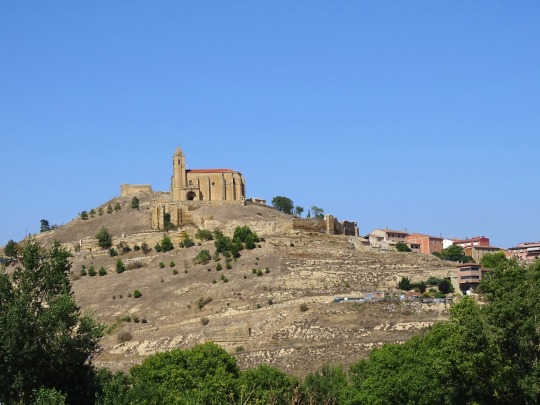





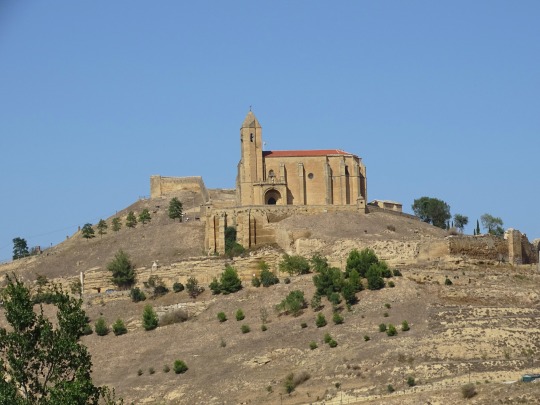




San Vicente de la Sonsierra, Spain (No. 3)
On January 6, 1172 Sancho VI of Navarre granted the charter of Laguardia to San Vicente and his alfoz. This was similar to the Fuero de Logroño.910His son Sancho VII of Navarre in 1194 built the castle and walled the area. Also in 1212 after the battle of Las Navas de Tolosa granted the coat of arms of the chains to the House of the Pool.
During the thirteenth century there were many struggles with the nearby castle of Briones. In 1367 she was involved in the war between Pedro I the Cruel and Enrique de Trastámara. Henry's troops, unable to seize the castle, burned the villages of San Vicente except for Ábalos. At the end of the conflict the village was in Navarrese hands. In 1373 a new treaty between Castile and Navarre returned Logroño to Castile, and continued to leave San Vicente within the kingdom of Navarre.
Due to the resistance of the inhabitants of the area against the troops of Enrique de Trastámara, Carlos II of Navarre granted nobility to its inhabitants and their descendants. With this he also sought to "attract new settlers, whatever their state or condition."
Source: Wikipedia
#San Vicente de la Sonsierra#Iglesia parroquial de Santa María la Mayor#Church of Santa María la Mayor#medieval bridge#Ebro River#landscape#tourist attraction#original photography#travel#vacation#cityscape#architecture#landmark#hill#La Rioja#Northern Spain#España#Spain#Southern Europe#summer 2021
6 notes
·
View notes
Text
Events 7.16 (before 1900)
622 – The Hijrah of Muhammad begins, marking the beginning of the Islamic calendar. 997 – Battle of Spercheios: Bulgarian forces of Tsar Samuel are defeated by a Byzantine army under general Nikephoros Ouranos at the Spercheios River in Greece. 1054 – Three Roman legates break relations between Western and Eastern Christian Churches through the act of placing a Papal bull (of doubtful validity) of Excommunication on the altar of Hagia Sophia during Saturday afternoon divine liturgy. Historians frequently describe the event as the formal start of the East–West Schism. 1212 – Battle of Las Navas de Tolosa: After Pope Innocent III calls European knights to a crusade, forces of Kings Alfonso VIII of Castile, Sancho VII of Navarre, Peter II of Aragon and Afonso II of Portugal defeat those of the Berber Muslim leader Almohad, thus marking a significant turning point in the Reconquista and in the medieval history of Spain. 1228 – The canonization of Saint Francis of Assisi 1232 – The Spanish town of Arjona declares independence and names its native Muhammad ibn Yusuf as ruler. This marks the Muhammad's first rise to prominence; he would later establish the Nasrid Emirate of Granada, the last independent Muslim state in Spain. 1251 – Celebrated by the Carmelite Order–but doubted by modern historians–as the day when Saint Simon Stock had a vision of the Virgin Mary. 1377 – King Richard II of England is crowned. 1536 – Jacques Cartier, navigator and explorer, returns home to St. Malo after claiming Stadacona (Quebec), Hochelaga (Montereal) and the River of Canada (St. Lawrence River) region for France. 1661 – The first banknotes in Europe are issued by the Swedish bank Stockholms Banco. 1683 – Manchu Qing dynasty naval forces under traitorous commander Shi Lang defeat the Kingdom of Tungning in the Battle of Penghu near the Pescadores Islands. 1769 – Father Junípero Serra founds California's first mission, Mission San Diego de Alcalá. Over the following decades, it evolves into the city of San Diego, California. 1779 – American Revolutionary War: Light infantry of the Continental Army seize a fortified British Army position in a midnight bayonet attack at the Battle of Stony Point. 1790 – The District of Columbia is established as the capital of the United States after signature of the Residence Act. 1809 – The city of La Paz, in what is today Bolivia, declares its independence from the Spanish Crown during the La Paz revolution and forms the Junta Tuitiva, the first independent government in Spanish America, led by Pedro Domingo Murillo. 1849 – Antonio María Claret y Clará founds the Congregation of the Missionary Sons of the Immaculate Heart of Mary, popularly known as the Claretians in Vic, in the province of Barcelona, Catalonia, Spain. 1858 – The last apparition of the Blessed Virgin Mary to Bernadette Soubirous in Lourdes, France. 1861 – American Civil War: At the order of President Abraham Lincoln, Union troops begin a 25-mile march into Virginia for what will become the First Battle of Bull Run, the first major land battle of the war. 1862 – American Civil War: David Farragut is promoted to rear admiral, becoming the first officer in United States Navy to hold an admiral rank.
1 note
·
View note
Text
The Battle of Las Navas de Tolosa, took place on 16 July 1212 and was an important turning point in the Reconquista and the medieval history of Spain.[9] The Christian forces of King Alfonso VIII of Castile, were joined by the armies of his rivals, Sancho VII of Navarre and Peter II of Aragon, in battle[10] against the Almohad Muslim rulers of the southern half of the Iberian Peninsula. The caliph al-Nasir (Miramamolín in the Spanish chronicles) led the Almohad army, made up of people from all over the Almohad Caliphate.
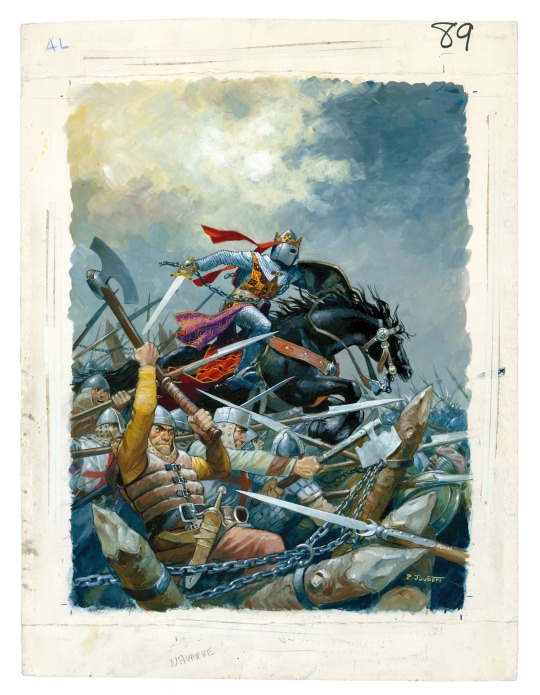
Sancho VII of Navarre at the Battle of Las Navas de Tolosa
by Pierre Joubert
190 notes
·
View notes
Text
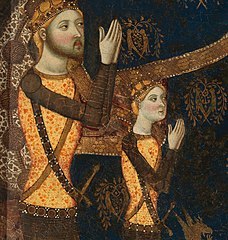


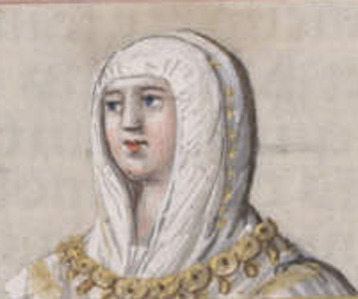

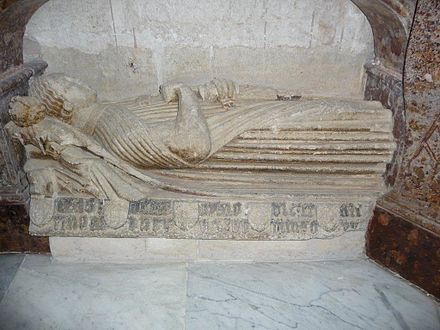

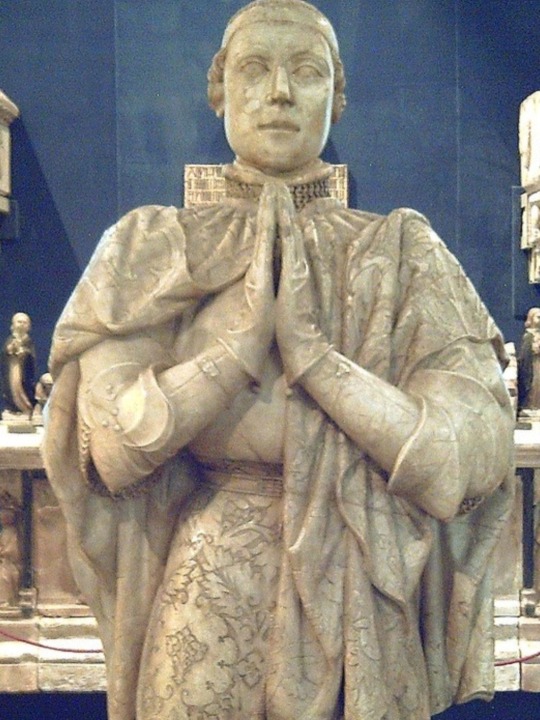

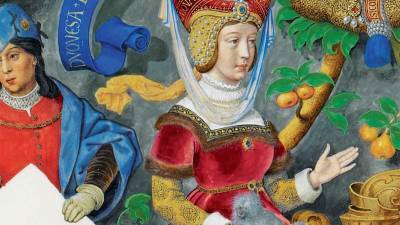
The Bastard Kings and their families
This is series of posts are complementary to this historical parallels post from the JON SNOW FORTNIGHT EVENT, and it's purpouse to discover the lives of medieval bastard kings, and the following posts are meant to collect portraits of those kings and their close relatives.
In many cases it's difficult to find contemporary art of their period, so some of the portrayals are subsequent.
1) Henry II of Castile ( 1334 – 1379), son of Alfonso XI of Castile and Leonor de Guzmán; and his son with Juana Manuel de Villena, John I of Castile (1358 – 1390)
2) His wife, Juana Manuel de Villena (1339 – 1381), daughter of Juan Manuel de Villena and his wife Blanca de la Cerda y Lara; with their daughter, Eleanor of Castile (1363 – 1415/1416)
3) His father, Alfonso XI of Castile (1311 – 1350), son of Ferdinand IV of Castile and his wife Constance of Portugal
4) His mother, Leonor de Guzmán y Ponce de León (1310–1351), daughter of Pedro Núñez de Guzmán and his wife Beatriz Ponce de León
5) His brother, Tello Alfonso of Castile (1337–1370), son of Alfonso XI of Castile and Leonor de Guzmán
6) His brother, Sancho Alfonso of Castile (1343–1375), son of Alfonso XI of Castile and Leonor de Guzmán
7) Daughters in law:
I. Eleonor of Aragon (20 February 1358 – 13 August 1382), daughter of Peter IV of Aragon and his wife Eleanor of Sicily; John I of Castile's first wife
II. Beatrice of Portugal (1373 – c. 1420) daughter of Ferdinand I of Portugal and his wife Leonor Teles de Meneses; John I of Castile's second wife
Son in law:
III. Charles III of Navarre (1361 –1425), son of Charles II of Navarre and Joan of Valois; Eleanor of Castile's huband
8) His brother, Peter I of Castile (1334 – 1369), son of Alfonso XI of Castile and Mary of Portugal
9) His niece, Isabella of Castile (1355 – 1392), daughter of Peter I of Castile and María de Padilla
10) His niece, Constance of Castile (1354 – 1394), daughter of Peter I of Castile and María de Padilla
#jonsnowfortnightevent2023#henry ii of castile#john i of castile#juana manuel de villena#eleanor of castile#alfonso xi of castile#leonor de guzmán#tello alfonso of castile#sancho alfonso of castile#peter i of castile#constance of castile#isabella of castile#asoiaf#a song of ice and fire#day 10#echoes of the past#historical parallels#medieval bastard kings#bastard kings and their families#eleanor of aragon#beatrice of portugal#charles iii of navarre#canonjonsnow
18 notes
·
View notes
Photo







ISABEL TVE 1x09
@timesthatneverwere
#perioddramaedit#weloveperioddrama#isabel tve#1x09#isabella i of castile#ferdinand ii of aragon#michelle jenner#rodolfo sancho
93 notes
·
View notes
Photo

Ava of Ribagorza, Countess of Castile
Daughter of Count Raymond II of Ribagorza and Garsenda Fesenzac, Ava was born circa 945. Queen Toda of Pamplona may have helped arrange Ava’s marriage to García Fernández, son of Count Fernán González of Castile, in 960. Ten years later, her spouse became the second Count of Castile after his father's death. Somehow, between battles and governance, the count and countess raised seven children to adulthood. Ava participated with her spouse in several donations to various convents.
Ava has been the subject of several legends that depict her in a negative light, and pointed out as involved in several of the conflicts and rebellions which occurred in Castile during the reign of her spouse. One known legend, named la leyenda de la condesa traidora ('The Legend of the Traitorous Countess'), she betrayed García Fernández, who was taken captured in a raid by the Moors and killed, after having committed adultery with Almanzor, the chief minister and virtual ruler of the caliphate of Córdoba.
Legend also accuse her of having encouraged her son Sancho in his rebellion against his father. The legends can probably be contributed to hostility to her as a foreigner in Castile: she is also identified as the leader of a more pacifist line at court, in opposition to the military line of her spouse against the Moors, which could also account for her bad publicity.
According to the legend, after the death of her spouse, she attempted to poison her son Sancho by handing him a cup of poison so she can leave Castile and get married to Almanzor. Sancho, however, forced her to drink it herself, which resulted in her death. The date of her death is in fact unknown: it is only known, that the year of 988 is the last year in which she can be confirmed alive. According to some sources, the countess died in 995 and was buried in the monastery of San Pedro de Cardeña.
9 notes
·
View notes
Photo
@asongofstarkandtargaryen
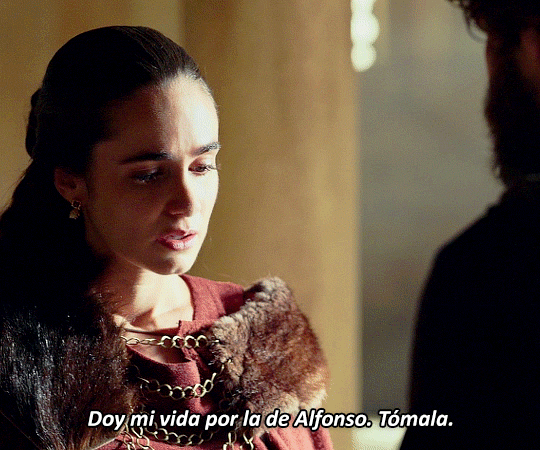



— I give my life for Alfonso’s. Take it. Please… — My sister…
— I’ll try to get you out of here. — No, listen to me, no! I forbid you! Sancho only needs an excuse to take your life. — I am not going to give up.
Urraca, tú no…
El Cid (2020–), 2x05
#El Cid#Urraca de Zamora#Alfonso VI de León#Sancho II de Castilla#Urraca of Zamora#Alfonso VI of Leon#Sancho II of Castile#Alicia Sanz#Jaime Olías#Francisco Ortiz#El Cid 2x05
35 notes
·
View notes
Text
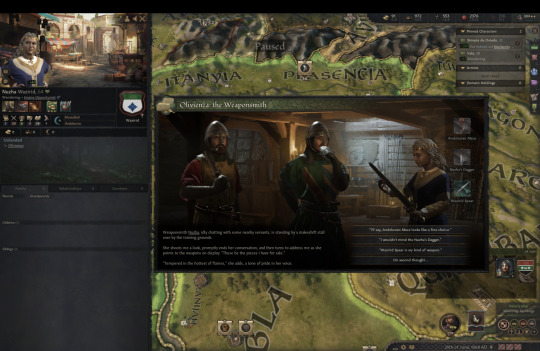

El Cid uproots his Camp again and travels to the City of Olivienza, south of the bou of Batalyaws. There, he visits the local Weaponsmith Nuzha Wazirid who offers him the wares she has on display - Andalusian Mace, Nuzha's Dagger and Wazirid Spear. El Cid selects and purchases the Wazirid Spear, a Masterwork Weapon that gives +7 Prowess and +6% Knight Effectiveness.


Another reason for traveling to Olivienza is to take up the Arbitration contract with Na'ib Yaghmurasen of Olivienza, the City's Muslim Mayor, who needs help with arbitrating the splitting of horse grazing land. The Loyal Vassals split the land fairly and well amongst the local magnates, thanks to their knowledge on horses.



After excelling in the contract for Na'ib Yaghmurasen, El Cid uses his weak hook on him to garner another contract - this time an "Eager Explorer Contract" which is a travel escort mission. Na'ib Yaghmurasen wishes to travel to A Corunna in Galicia where the Farum Brigantium is. El Cid makes preparations to travel with the Na'ib and his Caravan Master Martin.
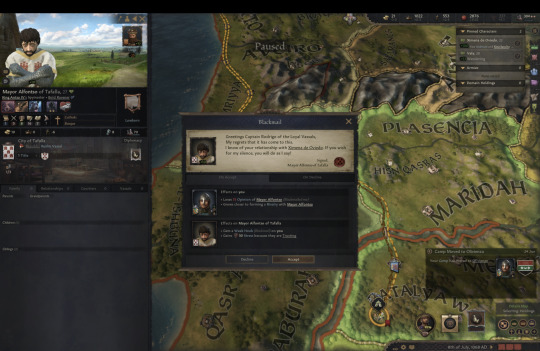
Along the way while he is travelling, El Cid receives a Blackmail letter from Mayor Alfontso of Tafalla, the Spymaster of King Antso IV of Navarre, who threatens to reveal El Cid's relationship with Ximena de Oviedo. In order to protect his Ximena (who is the Personal Physician of King Sancho of Castille) from going to Prison for being an adulterer, El Cid decides to give the Weak Hook to Mayor Alfontso.



While on the way back to Olivienza, journeying through Porto, El Cid encounters a Galician Wise Man by the name of Lucidio de Moscoso who offers him a "reading" of his future travels. El Cid rejects the offer politely by counter-offering him to "Come experience the future with me". This is fortuitous, as Lucidio makes a reliable knight with 10 Prowess, not to mention a good back-up Personal Physician should Najat die.
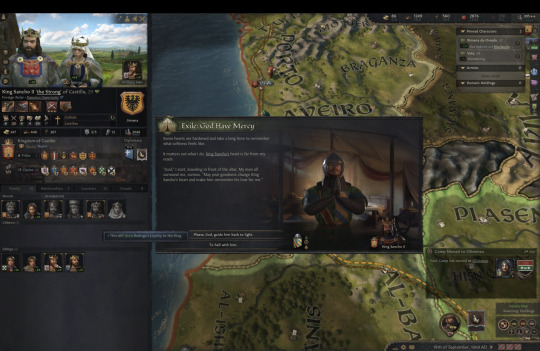
As a practising Catholic, El Cid prays at the alter for God's Mercy and also that the hardened heart of King Sancho softens that he may remember his love for El Cid.

El Cid moves his Camp to the southernmost tip of Iberia - Tarifa where a mosque stands. In the mosque he encounters a Muslim nun (? is this even historical?) by the name of sister Amat al-Wahhab. Since El Cid is not Muslim but Catholic, he decides against donating, asking for a blessing or stealing any donations there, but takes just a customary look around and departs.


El Cid takes the "Stand With Us" mercenary contract from Wali Qasim ibn Muhammad of Muluya, requiring him to aid as a defender in the Marrakeshi Conquest of the Wilayah of Muluya.

Finally on 5th December 1068, King Sancho II "the Strong" of Castille, visits El Cid's Camp to restore El Cid's honour and grant him pardon. Although the offer of becoming King Sancho's loyal vassal is very tempting, El Cid ultimately decides that he wants to continue adventuring with The Loyal Vassals as he has still so much to see and do as an Adventurer.

Meanwhile, El Cid had tried his best to befriend his former Bodyguard, the talented Vela, but to no avail - Vela remained on very good terms with El Cid, but that was it. It seems Vela will not be joining back with The Loyal Vassals. My head canon is that Vela was so traumatised by the death of his lover the Beautiful Guiomar, that he does not want to remember by going back.

We conclude today's play-through with the "Mio Cid" achievement - only 0.2% of players have this achievement. This is gotten by choosing all the remaining Loyal to King Sancho options during the game's scripted events for El Cid.
#ck3#crusader kings iii#crusader kings 3#el cid#rodrigo the campeador#roads to power#landless adventurer#mio cid
2 notes
·
View notes
Photo





Romance del rey Don Sancho
¡Rey don Sancho, rey don Sancho!
no digas que no te aviso,
que de dentro de Zamora
un alevoso ha salido;
llámase Vellido Dolfos,
hijo de Dolfos Vellido,
cuatro traiciones ha hecho,
y con esta serán cinco.
Si gran traidor fue el padre,
mayor traidor es el hijo.
Gritos dan en el real:
—¡A don Sancho han mal herido!
Muerto le ha Vellido Dolfos,
¡Gran traición ha cometido!
Desque le tuviera muerto,
metiose por un postigo,
por las calles de Zamora va dando voces y gritos:
—Tiempo era, doña Urraca, de cumplir lo prometido.
5 notes
·
View notes